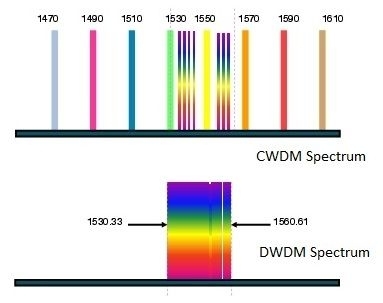- Related articles
- All Cisco ONS-SI-GE-ZX's information (List price, Specs, Datasheet PDF, Compatibility matr
- What is Overhead Fiber Optic Cable?
- What Does XFP Stand For?
- Applicable to 100BASE-BX Standard optical transceiver models
- All Cisco CWDM-SFP10G-1470's information (List price, Specs, Datasheet PDF, Compatibility
- All Cisco QSFP-40G-ER4 price 's information (List price, Specs, Datasheet PDF, Compatibili
- Optical Transceivers for Cisco 7600-ES+20G3C= Switch
- Optical Transceivers for Cisco SLM2024T-UK Switch
- All Cisco GLC-LH-SM's information (List price, Specs, Datasheet PDF, Compatibility matrix)
- All Cisco ONS-SI-155-SR-MM's information (List price, Specs, Datasheet PDF, Compatibility

Definition:
Coarse wavelength division multiplexing (CWDM) is a method of combining multiple signals on laser beams at various wavelengths for transmission along fiber optic cables, such that the number of channels is fewer than in dense wavelength division multiplexing (DWDM) but more than in standard wavelength division multiplexing (WDM).
Dense Wavelength Division Multiplexing (DWDM) is an optical multiplexing technology used to increase bandwidth over existing fiber networks. DWDM works by combining and transmitting multiple signals simultaneously at different wavelengths on the same fiber. The technology creates multiple virtual fibers, thus multiplying the capacity of the physical medium.
Difference WDM DWDM CWDM
The IT refers to a medium where information is transmitted via a link. If two locations want to communicate with each other, one link is sufficient. To connect more locations more links are required what if only one link e.g. between two cities is available, but more applications shall be connected? Using the WDM technology, fiber optic links can be utilized for data transmission more efficiently.
CWDM enables carriers to respond flexibly to diverse customer needs in metropolitan regions where fiber may be at a premium. However, it’s not really in competition with DWDM as both fulfill distinct roles that largely depend upon carrier-specific circumstances and requirements anyway. The point and purpose of CWDM is short-range communications. It uses wide-range frequencies and spreads wavelengths far apart from each other. Standardized channel spacing permits room for wavelength drift as lasers heat up and cool down during operation. By design, CWDM equipment is compact and cost-effective as compared to DWDM designs.
DWDM is designed for long-haul transmission where wavelengths are packed tightly together. Vendors have found various techniques for cramming 32, 64, or 128 wavelengths into a fiber. When boosted by Erbium Doped-Fiber Amplifiers (EDFAs)—a sort of performance enhancer for high-speed communications—these systems can work over thousands of kilometers. Densely packed channels aren’t without their limitations. First, high-precision filters are required to peel away one specific wavelength without interfering with neighboring wavelengths. Those don’t come cheap. Second, precision lasers must keep channels exactly on target. That nearly always means such lasers must operate at a constant temperature. High-precision, high-stability lasers are expensive, as are related cooling systems.
Conclusion:
The energy from the lasers in a CWDM system is spread out over a larger range of wavelengths than is the energy from the lasers in a DWDM system. The tolerance (extent of wavelength imprecision or variability) in a CWDM laser is up to ± 3 nm, whereas in a DWDM laser the tolerance is much tighter. Because of the use of lasers with lower precision, a CWDM system is less expensive and consumes less power than a DWDM system. However, the maximum realizable distance between nodes is smaller with CWDM.






































































